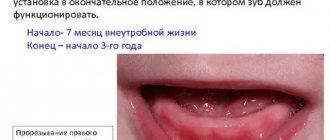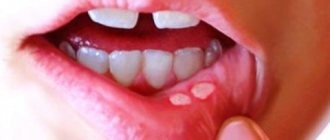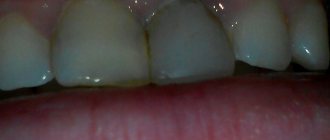Causes of delayed teeth emergence
A lot depends on nutrition: breastfed babies depend on the quality of breast milk. Babies who grow up on artificial formulas receive slightly more vitamins and minerals, because the formulas contain a clearly calculated amount of nutrients.
- If a child does not have a single tooth at 1 year of age, this may be a consequence of some previous disease: intestinal dysfunction, impaired metabolism, as well as insufficient calcium and vitamin D.
- Teeth may be delayed due to the special course of pregnancy; perhaps the mother suffered complications during the gestation period./li>
- Eruption after 12 months may mean that the tooth is not positioned correctly in the gum, for example, it is growing horizontally.
- Congenital absence of tooth buds in a baby. These are either hereditary disorders or a congenital pathology caused by a disruption in the normal course of pregnancy. It happens very rarely.
How can parents understand that at 12 months the baby’s teeth are simply delayed and they need to be patient, and when should they sound the alarm?
Pediatric dentists allow the first teeth to be delayed for 6 months, so if after the baby’s 1st birthday not a single baby tooth has grown, you should wait a little longer. Try to find out from your relatives about the timing and characteristics of the appearance of the first milk teeth in their childhood, perhaps this is just a family trait.
But if the teeth are already delayed by more than 6 months, and the baby’s gums do not even think of swelling, then you should contact a pediatric dentist. The specialist will conduct an examination and advise what needs to be done to help teeth appear faster.
In addition to the above reasons, the appearance of teeth after 12 months may be affected by the following:
- The teeth are located very tightly in the gums.
- There are diseases of the endocrine system, for example, hypothyroidism, due to which the activity of the endocrine glands is reduced.
- The baby suffered serious systemic diseases.
In this case, the pediatric dentist will recommend a biochemical blood test; the baby will need to have the thyroid gland examined, including an ultrasound examination. After the results are obtained, the dentist will be able to prescribe the necessary course of treatment.
Make an appointment
Specifics of the appearance of milk jugs
The eruption of milk ducts in children is a complex and deep mechanism inherent in genes, and preparation for this event is carried out in the child’s body almost from the moment of its birth in the mother’s womb. It is reliably known that baby teeth begin to form in the baby’s gums already in the second month of his life, and therefore any deviations already at this stage can play a negative role in the future.
Dairy teeth begin to erupt, on average, at the age of six months, although the first signs of the appearance of future teeth are sometimes noted as early as the fourth month after birth (in the form of small tubercles on the gums). The process of teething lasts until almost three years, and after another three years their gradual loss begins, with simultaneous replacement with permanent teeth that will remain with the person for the rest of his life.
Milk jugs begin to erupt, on average, at the age of six months.
The life cycle of milk jugs is a very important and integral part of the formation of a child, therefore any deviation in the order determined by genes can lead to negative consequences that can affect other areas of the child’s body.
Doctors more often encounter children with premature loss of baby teeth, but from time to time the opposite situations arise when milkmen, for some reason, are in no hurry to teethe. In order to be able to objectively assess possible irregularities in the appearance of milk jugs, you need to check the long-established, well-known formula that describes this process:
- central incisors appear at 6–10 (bottom) and 8–12 (top) months;
- lateral incisors appear at 10–16 (bottom) and 9–13 (top) months;
- fangs appear at 17–23 (bottom) and 16–22 (top) months;
- premolars appear at 14–18 (bottom) and 13–19 (top) months;
- molars appear at 23–31 (bottom) and 25–33 (top) months.
From this table, young parents should draw the first and most important conclusion for themselves: the spread in terms of timing is quite large, so if a child the same age as their child already has some teeth, but their baby still doesn’t, this is not necessarily a reason to panic. All children are individual, as well as their genes and living conditions, therefore only a pediatrician can draw any serious conclusions about the delay in the appearance of milk jugs.
Important! Teething is directly related to daily hormonal fluctuations in the child’s body, and the most active growth of teeth is observed from 20 pm to 1 am.
How to help your baby?
Initially, the dentist will take an X-ray of the baby's jaw to make sure that the baby has the rudiments of teeth inside. If there is, then eruption will happen soon. At first, the gums will swell a little and salivation will become very abundant: these are the main symptoms of the rapid appearance of teeth. You can help them a little:
- Teether toys are an excellent device for training gums; they help relieve severe itching and reduce pain.
- Mothers should learn how to gently massage their baby’s gums. It is better to massage with a clean finger lubricated with a special gel for children's gums.
- It is important to add healthy purees and healthy foods to your baby’s diet that will help the child’s body receive the necessary microelements and vitamins.
If the baby generally develops within normal limits, eats well, sleeps, is active and cheerful, then the absence of teeth at 1 year is definitely not a reason to panic. Each child develops at his own pace. In general, boys tend to lag slightly behind girls in some physiological parameters.
From this article it follows that you should not worry unnecessarily! If in any doubt, seek advice from a pediatric dentist at our Babydent
Show more tips
The main causes of decay of baby teeth
There are two age peaks when enamel damage is most intense. This is the early childhood period, when drinking a bottle is still relevant, as well as reaching 4-5 years of age. The reasons leading to bad baby teeth are practically the same.
The main factors contributing to the destruction of enamel can be represented as follows:
- hereditary predisposition;
- previous cold infections during the first trimester of pregnancy;
- excess carbohydrates in food;
- the baby’s habit of drinking sweets from a bottle before bed;
- poor oral hygiene;
- lack of calcium ions in the diet;
- weak immunity – frequent colds.
In children under 2-3 years of age, the front teeth more often deteriorate, and then in the older period - all the rest. Initially, this is due to the fact that it is the carbohydrate residues that settle after using the bottle that destroy the enamel of baby teeth.
How to help your baby teething
As an advertisement
Teething is an integral part of childhood and an important stage in a child’s development. For parents, this is new joy and new stress. Unfortunately, not all children tolerate the process of the appearance of their first teeth easily, and most parents remember this period as a series of sleepless nights. The child becomes restless, cries, sleep is disturbed, salivation increases, and the gums become swollen and red. Sometimes body temperature rises, appetite decreases and digestion is disrupted. The baby tries to put everything that comes to hand into his mouth.
On average, children erupt one new tooth every month, from 6 months of age until approximately 3 years of age, until they have a total of 20 baby teeth. The timing and order of teeth appearance may vary for each child.
Gum massage will help ease your baby's condition.
Massage can be performed either with your finger or with the help of special soft brushes and teethers. Chill the teether in the refrigerator for a short time, making sure it is cool and not cold like an ice cube. If the object is too cold, it can harm your gums and your baby. To facilitate teething, you should not give your child dry goods, bagels, a piece of apple or carrot, as crumbs can get into the respiratory tract.
Massage helps improve local microcirculation and additional anti-inflammatory effects, and coolness soothes the gums, dulling the sensitivity of the nerves that transmit pain, and gives relief to the child for a while. When massaging, you can use special dental gels for the gums.
How to choose a teething gel?
It is better to give preference to safer products based on natural ingredients. Avoid using topical anesthetics containing lidocaine as they should only be used as directed and under the supervision of a physician. Gel for gum massage “ Pansoral first teeth”
will help the child endure a difficult period easier. “Pansoral first teeth” is produced in France based on natural extracts of marshmallow, Roman chamomile and saffron. These medicinal herbs are known for their anti-inflammatory, antiseptic, soothing and softening effects. “Pansoral first teeth” is designed specifically for babies. The gel does not contain sugar, ethanol, or synthetic painkillers such as lidocaine or choline salicylate.
Recommendations for use of Pansoral first teeth
Wash your hands thoroughly and apply a small pea-sized amount of gel to your fingertip. Gently massage the gel onto your gums. "Pansoral first teeth" can be used as needed throughout the entire period of teething.
Pierre Fabre LLC 119435, Moscow, Savvinskaya embankment, 15. Tel., fax. www.pierre-fabre-russia.ru
IS NOT
MEDICINE.
Before use, consult a specialist.
Products by topic: [product](Pansoral)
How can you help your baby?
The main question, what to do if a child has no teeth at 8 months, requires an immediate solution. Therefore, the recommendations in such a situation are clear:
- never cause mechanical damage to the gums yourself;
- Chewing can be stimulated using a special device;
- review the baby’s nutritional issues by discussing them with the pediatrician;
- up to 11-12 months you can monitor the situation - nothing bad happens in the child’s body;
- If there are still no teeth, then you need to see a dentist.
What can a doctor do? Despite the child’s infancy, the doctor will prescribe an x-ray of the jaws. This will help diagnose edentia. In any case, you should always strictly follow the recommendations of the pediatric dentist, who will always try to help the baby.
What do the deadlines depend on?
When determining why a child’s teeth do not grow, you need to take into account the following factors:
- the formation process depends on gender, girls develop teeth earlier than boys;
- The baby's growth also affects teething. So, if the baby is not tall, then teething will begin later;
- upper and lower jaws. At what stage does teething occur earlier? On the bottom.
A child’s bite has two stages – temporary and permanent. If it is temporary, then teething occurs less frequently. The location of the teeth also matters, for example, the second and third molars emerge later than the others. It is influenced by development and climate, place of residence, heredity - when the parents began to teethe, their children will begin to do so at about the same age.











